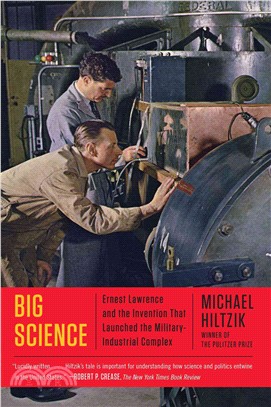Big Science ─ Ernest Lawrence and the Invention That Launched the Military-Industrial Complex
商品資訊
ISBN13:9781451675764
出版社:Simon & Schuster
作者:Michael Hiltzik
出版日:2016/07/26
裝訂/頁數:平裝/528頁
規格:22.9cm*15.9cm*3.2cm (高/寬/厚)
商品簡介
相關商品
商品簡介
The epic story of how science went “big” and the forgotten genius who started it all—“entertaining, thoroughly researched…partly a biography, partly an account of the influence of Ernest Lawrence’s great idea, partly a short history of nuclear physics and the Bomb” (The Wall Street Journal).
Since the 1930s, the scale of scientific endeavor has grown exponentially. The first particle accelerator could be held in its creator’s lap, while its successor grew to seventeen miles in circumference and cost ten billion dollars. We have invented the atomic bomb, put man on the moon, and probed the inner workings of nature at the scale of subatomic particles—all the result of Big Science, the model of industrial-scale research paid for by governments, departments of defense, and corporations that has driven the great scientific projects of our time.
The birth of Big Science can be traced nearly nine decades ago in Berkeley, California, when a young scientist with a talent for physics declared, “I’m going to be famous!” His name was Ernest Orlando Lawrence. His invention, the cyclotron, would revolutionize nuclear physics, but that was only the beginning of its impact, which would be felt in academia, industry, and international politics. It was the beginning of Big Science.
“An exciting book….A bright narrative that captures the wonder of nuclear physics without flying off into a physics Neverland….Big Science is an excellent summary of how physics became nuclear and changed the world” (The Plain Dealer, Cleveland). This is the “absorbing and expansive” (Los Angeles Times) story that is “important for understanding how science and politics entwine in the United States…with striking details and revealing quotations” (The New York Times Book Review).
Since the 1930s, the scale of scientific endeavor has grown exponentially. The first particle accelerator could be held in its creator’s lap, while its successor grew to seventeen miles in circumference and cost ten billion dollars. We have invented the atomic bomb, put man on the moon, and probed the inner workings of nature at the scale of subatomic particles—all the result of Big Science, the model of industrial-scale research paid for by governments, departments of defense, and corporations that has driven the great scientific projects of our time.
The birth of Big Science can be traced nearly nine decades ago in Berkeley, California, when a young scientist with a talent for physics declared, “I’m going to be famous!” His name was Ernest Orlando Lawrence. His invention, the cyclotron, would revolutionize nuclear physics, but that was only the beginning of its impact, which would be felt in academia, industry, and international politics. It was the beginning of Big Science.
“An exciting book….A bright narrative that captures the wonder of nuclear physics without flying off into a physics Neverland….Big Science is an excellent summary of how physics became nuclear and changed the world” (The Plain Dealer, Cleveland). This is the “absorbing and expansive” (Los Angeles Times) story that is “important for understanding how science and politics entwine in the United States…with striking details and revealing quotations” (The New York Times Book Review).
主題書展
更多
主題書展
更多書展今日66折
您曾經瀏覽過的商品
購物須知
外文書商品之書封,為出版社提供之樣本。實際出貨商品,以出版社所提供之現有版本為主。部份書籍,因出版社供應狀況特殊,匯率將依實際狀況做調整。
無庫存之商品,在您完成訂單程序之後,將以空運的方式為你下單調貨。為了縮短等待的時間,建議您將外文書與其他商品分開下單,以獲得最快的取貨速度,平均調貨時間為1~2個月。
為了保護您的權益,「三民網路書店」提供會員七日商品鑑賞期(收到商品為起始日)。
若要辦理退貨,請在商品鑑賞期內寄回,且商品必須是全新狀態與完整包裝(商品、附件、發票、隨貨贈品等)否則恕不接受退貨。
























